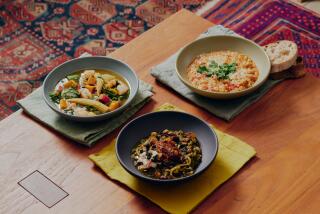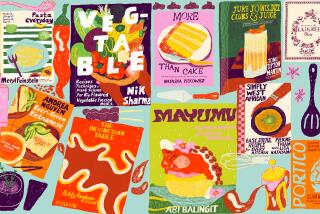Salmon in Winter : A Fish You Can Treat Like Meat : Cooking: Unlike other seafood, salmon has a gamier flavor that’s suited to heartier, seasonal recipes.
January weather makes us rush to our stoves and cook the kind of food we avoid at other seasons--long-cooked braises, stews and roasts; rich, saucy dishes that keep us warm and contented.
But this kind of cooking need not be restricted to the usual rich red meats and fatty birds. Unlikely ingredients can be adapted to achieve a hearty dish that is both rib-stickingly satisfying and lighter on our constitution.
We forget that salmon is terrific in winter recipes. It has a flavor unlike that of other fish--nutty, woodsy, almost gamy. And unlike more delicately textured fish (which are usually best quickly sauteed, steamed or broiled), salmon shines when roasted or braised.
Salmon are found in both the Atlantic and Pacific oceans. Spawned in rivers, they go down to the sea to live, then travel back upstream to the spot where they were hatched to reproduce and complete their life cycle. Their diet at sea is post-larval herring and other fish--it’s what gives their flesh its famous salmon-pink color. Once they enter a river on the return pilgrimage to their spawning grounds, they take no food.
A large salmon-farming industry has grown up in Scandinavia. The farm-raised Norwegian salmon eat better than their savage cousins because their lighter-pink flesh has a finer texture and tastes gamier and less fishy. All salmon are considered fatty fish, but farm-raised salmon is richer than wild salmon, which itself has a fat content of about 17%. (Remember, those of you who restrict fat consumption, that this is healthy fat.)
This fat protects the fish not only from the cold of the northern waters but also from the inexactitude of the cook. Salmon can be cooked for a longer time than other fish without deteriorating. For me, the unctuous farm-raised salmon are the best for cooking.
Salmon’s gamy flavor allows it to be treated like meat. Baked Salmon Stuffed With Cabbage, Chestnuts and Bacon is a recipe I developed as an alternative holiday feast (the original used a pork loin roast). Baked Salmon With Two Purees is an homage to squab. Finally, Salmon Roasted in Red Wine With Dried Apricots is in origin a lamb recipe but delicious when made with salmon. (The red wine and apricot accompaniment is also delicious with fresh-water fish such as carp or strong-flavored, oily fish such as bluefish or mackerel.)
Serve the salmon arranged on a large platter and offer the sauce on the side. In accordance with our American custom of putting too many different things on the same plate, accompany this dish with a number of vegetables and don’t worry about things going together. The dish will be more festive--and it’s a good excuse to break the rules.
BAKED SALMON
STUFFED WITH
CABBAGE,
CHESTNUTS AND
BACON
32 chestnuts
1/2 pound slab bacon, cut into 1/2-inch cubes
2 small red cabbages, finely shredded (about 4 cups)
1 (5-pound) whole salmon
1/2 teaspoon freshly ground black pepper
2 cups dry white wine
1/2 cup plus 2 tablespoons unsalted butter
1/4 cup finely minced shallots
1 cup white vinegar
1/4 teaspoon salt
Using small knife, make slit in each chestnut and spread on baking sheet. Bake at 350 degrees 30 to 35 minutes. Remove from oven. When cool enough to handle, peel chestnuts.
Place bacon in large skillet over medium heat and cook, stirring, about 5 minutes. Add cabbages. Cook, covered, another 6 to 7 minutes or until tender. Remove from heat. Chop chestnuts coarsely, add to cabbage mixture and transfer to bowl.
Sprinkle cavity of salmon with pepper and stuff with cabbage mixture. Place salmon in roasting pan and add 1 cup wine and 2 tablespoons butter. Bake at 350 degrees, uncovered, 20 minutes. Turn salmon over and cook another 15 to 20 minutes, or until just barely cooked at bone.
For sauce, combine shallots, remaining 1 cup wine, vinegar and salt in small saucepan. Cook over medium heat until mixture is almost dry. Remove from heat and whisk in remaining 1/2 cup butter. Place salmon on large platter and serve sauce on side. Makes 4 to 6 servings.
BAKED SALMON WITH
TWO PUREES
1 pound celery root
1 pound onions, coarsely chopped
1 1/2 pounds mushrooms
2 tablespoons minced shallots
3/4 teaspoon salt
1 cup dry white wine
1/2 tablespoon finely minced garlic
2 cups fish stock
1 cup whipping cream
3 tablespoons chopped parsley
4 salmon steaks or fillets, about 7 ounces each
1 tablespoon melted butter
2 tablespoons unsalted butter
Remove and discard celery root tops. Peel off thick, black outer layer then cut celery root into pieces large enough to fit into bowl of food processor. Fit processor with shredding blade and shred root.
Combine onions and celery root in heavy saucepan. Cook, covered, over low heat 20 minutes, stirring frequently. Remove cover and cook, stirring, another 10 minutes or until mixture is dry. Keep in warm oven.
Place mushrooms, shallots and 1/4 teaspoon salt in food processor and puree until smooth. Scrape mixture into medium saucepan and cook, uncovered, over medium heat, stirring, until moisture has evaporated and mixture is dry. Remove from heat and keep in warm oven.
Combine white wine, garlic and 1/4 teaspoon salt in another medium saucepan. Cook, uncovered, over medium heat until reduced by half. Add fish stock and reduce again until mixture starts to thicken. Add whipping cream and reduce until sauce coats back of spoon. Scrape into blender. Add parsley and blend until smooth. Return mixture to saucepan.
Place salmon in buttered 9-inch baking dish and coat surface with melted butter. Sprinkle with 1/4 teaspoon salt and broil 5 minutes. Set parsley cream over medium heat and whisk in unsalted butter.
To serve, place dollops of celery root puree and mushroom puree on individual warm plates. Arrange piece of salmon on top between 2 purees and spoon some parsley cream sauce over top of fish. Makes 4 servings.
SALMON ROASTED IN
RED WINE WITH DRIED
APRICOTS
1 1/4 pounds salmon fillets
1/4 cup flour
2 tablespoons oil
1 cup dry red wine
1/2 cup fish stock
1 cup dried apricots
Salt
Freshly ground pepper
2 tablespoons unsalted butter
Pat salmon dry with paper towels. Dust fillets with flour, shaking off excess.
Heat oil in 12-inch oven-proof skillet or roasting pan over medium heat on stove. Add salmon and brown on all sides. Remove to plate and discard oil. Add red wine and stock to skillet and bring to boil. Return salmon to skillet. Add apricots and season to taste with salt and pepper.
Bake, uncovered, at 375 degrees 7 minutes. Then transfer skillet to stove-top and remove fish to carving board. Cook liquid in skillet over high heat, stirring, until thickened slightly. Remove from heat and whisk in butter.
Cut salmon into 1/2-inch slices. Arrange on serving platter and spoon sauce over top. Makes 4 servings.
Note: Fish cooked in red wine should be served with red wine. I suggest young, light fruity red, such as Beaujolais.
More to Read
Eat your way across L.A.
Get our weekly Tasting Notes newsletter for reviews, news and more.
You may occasionally receive promotional content from the Los Angeles Times.










